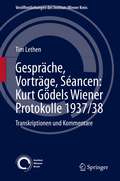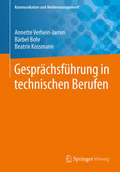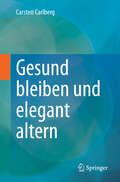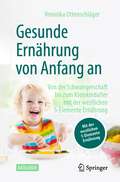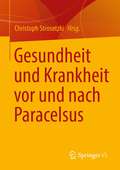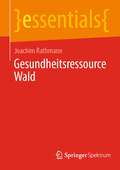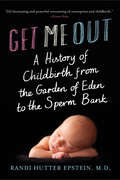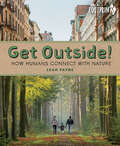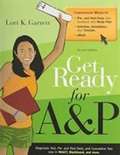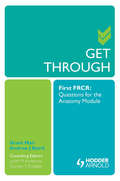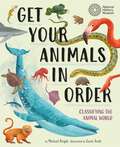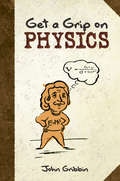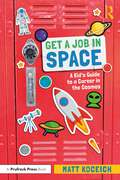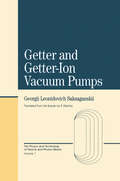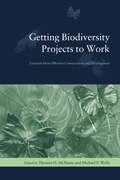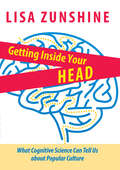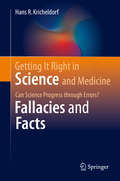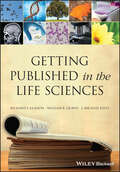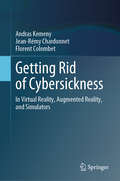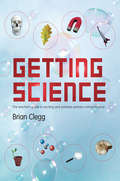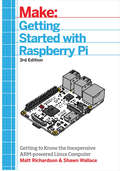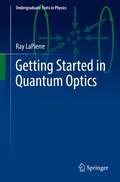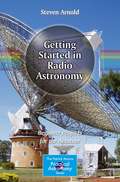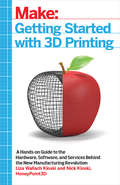- Table View
- List View
Gespräche, Vorträge, Séancen: Transkriptionen und Kommentare (Veröffentlichungen des Instituts Wiener Kreis #31)
by Tim LethenThis book provides detailed transcriptions of two notebooks written by Kurt Gödel in Vienna in 1937/38 in the nearly forgotten Gabelsberger shorthand system. The first of these notebooks, simply entitled as the Protokoll-book, contains notes on conversations Gödel had with people like Rudolf Carnap, Rose Rand, Friedrich Waismann, Else Frenkel-Brunswik, and many others who were—at least to some degree—connected to the Vienna Circle. It also covers detailed descriptions of the regular meetings organized by Edgar Zilsel. The second notebook includes notes on a series of lectures given at the Vienna Psychological Institute, which was led by Karl Bühler at the time. Both notebooks are part of Gödel’s huge Nachlass kept at the Institute for Advanced Study in Princeton, which consists of literally thousands of stenographic pages covering logic and the foundations of mathematics, philosophy, physics, and theology. The now transcribed and commented notes reveal a very personal side of Gödel which has—to a large extent—been unknown to a mainly scientific-oriented audience. The book is of interest to people wanting to learn about Gödel’s personal background in Vienna in the late 1930s as well as his keen interest in philosophy, psychology, and parapsychology.
Gesprächsführung in technischen Berufen
by Annette Verhein-Jarren Bärbel Bohr Beatrix KossmannDieser praxisnahe Gesprächsleitfaden wurde speziell für technische Berufe entwickelt. Er zeichnet sich durch den Bezug zum industriellen Umfeld aus und bietet zahlreiche Beispiele für Gesprächsanlässe und typische Gesprächsthemen.Praktische Hinweise zeigen, wie Gespräche konstruktiv genutzt werden können, um- Fachwissen auszubauen und zu teilen,- Ursachen von Missverständnissen zu erkennen, - Interessen überzeugend zu vertreten. Daneben bietet es die erforderlichen theoretischen Grundlagen.Die ZielgruppenDas Buch eignet sich gleichermaßen für Studierende sowie für junge Fachkräfte aus Ingenieurwesen und Technik.
Gesund bleiben und elegant altern
by Carsten CarlbergWer möchte nicht gesund bleiben und elegant altern? Dieses Buch bietet keine klassischen Ratschläge, sondern vermittelt ein tiefes Verständnis der Prozesse in unserem Körper, insbesondere des Immunsystems. Erfahren Sie, wie ein gut funktionierendes Immunsystem uns vor Infektionen und Krebs schützt, warum Überreaktionen zu Allergien und Autoimmunerkrankungen führen können und wie unser Lebensstil die Immunantwort beeinflusst. Dieses Buch richtet sich an Laien mit biologischen Grundkenntnissen, die mehr über die faszinierenden Mechanismen unseres Immunsystems erfahren möchten. Es ist ideal für alle, die Verantwortung für ihre Gesundheit übernehmen und die wissenschaftlichen Grundlagen für ein gesundes und langes Leben verstehen wollen. Mit klaren Erklärungen und wissenschaftlich fundierten Informationen zeigt dieses Buch, wie Sie Ihr Immunsystem stärken und somit Ihre Gesundheit und Lebensqualität verbessern können. Ein unverzichtbarer Leitfaden!
Gesunde Ernährung von Anfang an: Von der Schwangerschaft bis zum Kleinkindalter mit der westlichen 5-Elemente Ernährung
by Veronika OttenschlägerDas Beste aus zwei Welten für Ihr Kind!Dieser Ratgeber zeigt Ihnen, wie die Ernährung in der Schwangerschaft und Stillzeit sowie vom Säuglings- bis zum Kleinkindalter mit der einzigartigen Kombination von chinesischer und westlicher Ernährung ganz einfach umgesetzt werden kann. Fachlich fundiertes Wissen aus beiden Ernährungsrichtungen und viele wertvolle Tipps und Tricks sowie Rezepte mit pfiffigen Ideen, erleichtern die Anwendung im Familienalltag. Ebenso behandelt werden spezielle Ernährungsformen, wie z.B.: vegane und vegetarische Ernährung, Fütterungsstörungen, Unverträglichkeiten, Übergewicht, Beikost und Baby Led Weaning. Ein Überblick zu den wichtigsten heimischen Grundnahrungsmitteln, die in diesen Lebensphasen geeignet und ungeeignet sind, hilft bei der richtigen Auswahl. Das Buch ist für Eltern, Pädagogen, Großeltern und all jene gedacht, denen eine gesunde Ernährung am Herzen liegt.
Gesundheit und Krankheit vor und nach Paracelsus
by Christoph StrosetzkiBedeutend ist Theophrast von Hohenheim (ca. 1493/4–1541), genannt Paracelsus, vor allem durch sein Aufbegehren gegen die klassischen antiken und arabisch-mittelalterlichen Autoritäten in der Medizin. Grundlage sollen nicht mehr die überlieferten Schriften, sondern experientia, experimenta und ratio sein. Von dieser Basis soll künftig ausgegangen werden, was Paracelsus auch dadurch unterstreicht, dass er seine Schriften in deutscher Sprache veröffentlicht. Indem er sich gegen die dogmatische Auslegung antiker Texte wandte, wollte er die Ära Galens beenden. Die Chirurgie wollte er auf universitären Rang erheben. Nach Paracelsus ist es die Natur, die heilt, wobei der Arzt nur Helfer ist. Wenn er Gesundheit als harmonische Ordnung im organischen Ablauf definiert, dann ist er bestrebt, Makrokosmos und Mikrokosmos, Diesseits und Jenseits, in Einklang zu bringen. Die Welt ist für ihn kein Nebeneinander isolierter Elemente, sondern eine Einheit. Auch beim Menschen erscheint ihm Sinnliches und Seelisches aufeinander bezogen. Archeus nennt er ein immaterielles Prinzip, in dem er den Träger der belebenden Kraft in der Natur und im Menschen, also im Makrokosmos wie im Mikrokosmos, festmacht. Im Sinne der Renaissance sieht er den Menschen als Mittelpunkt des Kosmos und seine Aufgabe im Erkennen der Welt.
Gesundheitsressource Wald (essentials)
by Joachim RathmannJoachim Rathmann stellt die interdisziplinären Bezüge von Wäldern und menschlicher Gesundheit dar. Wälder stellen zahlreiche Ökosystemleistungen für das Überleben, das Wohlbefinden und die Erhaltung und Stärkung von Gesundheit von Menschen zur Verfügung. Wälder bieten multisensorische Erholungsräume und können daher als eine Ressource angesehen werden, die sowohl auf körperliche, mentale und soziale Aspekte von Gesundheit positiv wirkt. Der Autor bereitet natur-, sozial,- und geisteswissenschaftliche Untersuchungen für eine breit gefächerte Leserschaft verständlich, anschaulich und übersichtlich auf.
Get Me Out: A History of Childbirth from the Garden of Eden to the Sperm Bank
by Randi Hutter Epstein"[An] engrossing survey of the history of childbirth."--Stephen Lowman, Washington Post Making and having babies--what it takes to get pregnant, stay pregnant, and deliver--have mystified women and men throughout human history. The insatiably curious Randi Hutter Epstein journeys through history, fads, and fables, and to the fringe of science. Here is an entertaining must-read--an enlightening celebration of human life.
Get Outside!: How Humans Connect with Nature (Orca Footprints #30)
by Leah PayneWe know spending time in nature is good for us, but why? And how did people become so disconnected from the natural world, anyway? Get Outside! How Humans Connect with Nature explores the important relationship between people and nature. It asks big questions, like Are humans part of nature or separate from it? and Do all people have equal access to nature? By discussing global issues such as the climate crisis and environmental racism, the book shows us that, by strengthening our relationship with the natural world, we can learn how to take care of the environment and to let the environment take care of us too. The epub edition of this title is fully accessible.
Get Ready For A & P (Second Edition)
by Lori K. GarrettThe goal of Get Ready for A & P is to help students get a strong start in anatomy and physiology, and to master the material not just for exams, but for their future as well.
Get Through First FRCR: Questions for the Anatomy Module (Get Through)
by Judith Anderson Grant Mair Andrew Baird Gordon FindlaterCompletely up to date with the latest exam changes, Get Through First FRCR: Questions for the Anatomy Module offers a valuable insight into the new anatomy exam. 170 high quality practice cases, each containing 5 question stems, are presented according to syllabus topics, accurately reflecting the content, style and level of difficul
Get Your Animals in Order: Classifying the Animal World
by Michael BrightAnimals are so familiar but what makes an animal an animal? Produced in partnership with the Natural History Museum (NHM), this clever and clear explanation of animal classification puts your animals in order and explains why classifying animals is important.From whales to worms and snakes to stinkbugs, every creature ever discovered has been identified and added to a group within the animal kingdom. Scientists use this classification system to help them research, discover and save species. This children's book showcases the amazingly diverse range of animals found around the world and the different features that help determine their place in the animal kingdom. We see the similarities, differences and connections between animal groups, and discover how classification helps scientists conserve animals and their habitats.'Odd-one-out' examples tell of peculiar animals that don't quite fit the natural order, such as egg-laying mammals and fish that climb trees.Includes a zoology timeline of the people and places that have influenced the study of animals
Get a Grip on Physics (Dover Books on Physics)
by John GribbinA physicist and author of popular-science books offers down-to-earth discussions of string theory, black holes, superfluidity, and other cosmic oddities. Playful engravings and cartoons illustrate these imaginative explanations of the laws of physics and their application to everything from massive stars to miniscule atoms. Suitable for readers of all ages.
Get a Job in Space: A Kid's Guide to a Career in the Cosmos
by Matt KoceichGet a Job in Space is your one-stop-shop to learning everything there is to know about working in space…and the STEM subjects you need to get there! From celestial science to intergalactic technology, discover what astronauts, technicians and engineers need to know to do their jobs. Would you rather study how plants grow on Mars than design a rocket? Explore your perfect career match, and dive into additional resources, classes and tips to help launch you into space. This book is a must-have for kids fascinated by the cosmos, astronauts and the people who get them there.
Getter And Getter-Ion Vacuum Pumps
by Georgii L. SaksaganskiiThis unique monograph discusses all aspects of the design and operation of electrophysical ultrahigh-vacuum pumps (EUVP). The adsorption-diffusion model of interaction of gas molecules with metal getters is presented, together with getter films sorption characteristics. A mathematical model of molecular transfer in electrophysical pumps and the principles and criteria of their energy and structural-geometrical optimization are proposed; and the physical processes in the pumps are analyzed during the pumping out of both active and inert gases. Also presented are the generic and specific pump parameters and the methods of calculating their main characteristics. Of special interest are discussions of the design, structure, and operational featuress of evaporation getter and ion-getter pumps with thermal deposition of getter films; EUVP with plasma evaporation; sputter-ion pumps with and without built-in evaporators; pumping out methods based on nonevaporable getters; and impantation, membrane and catalytic pumps. This book will appeal to experts and students in experimental physics, electronics, fusion accelerator techniques and electrophysical and vacuum apparatus design.
Getting Biodiversity Projects to Work: Towards More Effective Conservation and Development
by Mcshane Thomas O. Michael P. WellsThis book explores both the theoretical and practical underpinnings of integrated conservation and development. It synthesizes existing experience to better inform conservationists and decision makers of the role ICDPs play in conservation and management and analyzes their successes and shortcomings.
Getting Biodiversity Projects to Work: Towards More Effective Conservation and Development (Biology and Resource Management Series)
by Michael P. Wells Eds. Thomas O. McShaneThis book explores both the theoretical and practical underpinnings of integrated conservation and development. It synthesizes existing experience to better inform conservationists and decision makers of the role ICDPs play in conservation and management and analyzes their successes and shortcomings.
Getting Inside Your Head: What Cognitive Science Can Tell Us about Popular Culture
by Lisa ZunshineUsing the psychological concept called theory of mind, Lisa Zunshine explores the appeal of movies, novels, paintings, musicals, and reality television.Winner of the CHOICE Outstanding Academic Title of the Choice ACRLWe live in other people's heads: avidly, reluctantly, consciously, unaware, mistakenly, and inescapably. Our social life is a constant negotiation among what we think we know about each other's thoughts and feelings, what we want each other to think we know, and what we would dearly love to know but don't.Cognitive scientists have a special term for the evolved cognitive adaptation that makes us attribute mental states to other people through observation of their body language; they call it theory of mind. Getting Inside Your Head uses research in theory of mind to look at movies, musicals, novels, classic Chinese opera, stand-up comedy, mock-documentaries, photography, and reality television. It follows Pride and Prejudice’s Mr. Darcy as he tries to conceal his anger, Tyler Durden as he lectures a stranger at gunpoint in Fight Club, and Ingrid Bergman as she fakes interest in horse races in Notorious.This engaging book exemplifies the new interdisciplinary field of cognitive cultural studies, demonstrating that collaboration between cognitive science and cultural studies is both exciting and productive.
Getting It Right in Science and Medicine
by Hans R. KricheldorfThis book advocates the importance and value of errors for the progress of scientific research! Hans Kricheldorf explains that most of the great scientific achievements are based on an iterative process (an 'innate self-healing mechanism'): errors are committed, being checked over and over again, through which finally new findings and knowledge can arise. New ideas are often first confronted with refusal. This is so not only in real life, but also in scientific and medical research. The author outlines in this book how great ideas had to ripen over time before winning recognition and being accepted. The book showcases in an entertaining way, but without schadenfreude, that even some of the most famous discoverers may appear in completely different light, when regarding errors they have committed in their work. This book is divided into two parts. The first part creates a fundament for the discussion and understanding by introducing important concepts, terms and definitions, such as (natural) sciences and scientific research, laws of nature, paradigm shift, and progress (in science). It compares natural sciences with other scientific disciplines, such as historical research or sociology, and examines the question if scientific research can generate knowledge of permanent validity. The second part contains a collection of famous fallacies and errors from medicine, biology, chemistry, physics and geology, and how they were corrected. Readers will be astonished and intrigued what meanders had to be explored in some cases before scientists realized facts, which are today's standard and state-of-the-art of science and technology. This is an entertaining and amusing, but also highly informative book not only for scientists and specialists, but for everybody interested in science, research, their progress, and their history!
Getting Published in the Life Sciences
by Richard J. Gladon J. Michael Kelly William R. GravesThe goal of this book is to make it easier for scientists, especially those new to scientific writing, to write about their results and to get their manuscripts accepted in peer-reviewed journals. The book covers each step throughout the submission process, from organizing and outlining the manuscript, presenting statistical data and results, to what happens during the in-house manuscript review process and what to do if an article is initially rejected. In addition to providing practical exercises on these topics, the book focuses on helping writers distil their research into concise take-home messages for readers, in order to convey information as clearly as possible to the target audience.
Getting Rid of Cybersickness: In Virtual Reality, Augmented Reality, and Simulators
by Andras Kemeny Jean-Rémy Chardonnet Florent ColombetThis book provides a concise overview of VR systems and their cybersickness effects, giving a description of possible reasons and existing solutions to reduce or avoid them. Moreover, the book explores the impact that understanding how efficiently our brains are producing a coherent and rich representation of the perceived outside world would have on helping VR technics to be more efficient and friendly to use.Getting Rid of Cybersickness will help readers to understand the underlying technics and social stakes involved, from engineering design to autonomous vehicle motion sickness to video games, with the hope of providing an insight of VR sickness induced by the emerging immersive technologies. This book will therefore be of interest to academics, researchers and designers within the field of VR, as well as industrial users of VR and driving simulators.
Getting Science: The Teacher's Guide to Exciting and Painless Primary School Science
by Brian CleggScience is rightly a fundamental part of primary school education, but that doesn’t make it easy to teach - especially for teachers without a science background. This straight talking book from an experienced science writer and communicator looks at how to make the most of it and give primary school children a good grounding in the topic. Getting Science sets out to engage the sense of wonder. The science in this book is not for the children, but for the adults who have to explain it. Starting with a whirlwind tour of the great milestones of modern science, Getting Science goes on to take each of the main curriculum topics and give it a new twist. It provides the information needed to understand the key topics better and be able to put them across with enthusiasm and energy. This book will help teachers to get children excited by science, to understand science rather than just answer questions. Getting Science makes science fun, approachable and comprehensible to those who just don’t get it.
Getting Started With Raspberry Pi: An Introduction to the Fastest-Selling Computer in the World
by Shawn Wallace Matt RichardsonThe Raspberry Pi is a credit card-sized computer that plugs into your TV and a keyboard. It is a capable little computer which can be used in electronics projects, and for many of the things that your desktop PC does, like spreadsheets, word processing, browsing the internet, and playing games. It also plays high-definition video. This book takes you step-by-step through many fun and educational possibilities. Take advantage of several preloaded programming languages. Use the Raspberry Pi with Arduino. Create Internet-connected projects. Play with multimedia. With Raspberry Pi, you can do all of this and more.
Getting Started in Quantum Optics (Undergraduate Texts in Physics)
by Ray LaPierreThis book, based on classroom-tested lecture notes, provides a self-contained one semester undergraduate course on quantum optics, accessible to students (and other readers) who have completed an introductory quantum mechanics course and are familiar with Dirac notation and the concept of entanglement. The book covers canonical quantization, the harmonic oscillator, vacuum fluctuations, Fock states, the single photon state, quantum optical treatment of the beam splitter and the interferometer, multimode quantized light, and coherent and incoherent states. Metrology is a particular area of emphasis, with the book culminating in a treatment of squeezed light and its use in the laser interferometer gravitational-wave observatory (LIGO). The Heisenberg limit is described, along with NOON states and their application in super-sensitivity, super-resolution and quantum lithography. Applications of entanglement and coincidence measurements are described including ghost imaging, quantum illumination, absolute photodetector calibration, and interaction-free measurement. With quantum optics playing a central role in the so-called “second quantum revolution,” this book, equipped with plenty of exercises and worked examples, will leave students well prepared to enter graduate study or industry.
Getting Started in Radio Astronomy
by Steven ArnoldRadio astronomy is a mystery to the majority of amateur astronomers, yet it is the best subject to turn to when desirous of an expanded knowledge of the sky. This guide intends to instruct complete newcomers to radio astronomy, and provides help for the first steps on the road towards the study of this fascinating subject In addition to a history of the science behind the pursuit, directions are included for four easy-to-build projects, based around long-term NASA and Stanford Solar Center projects The first three projects constitute self-contained units available as kits, so there is no need to hunt around for parts. The fourth - more advanced - project encourages readers to do their own research and track down items. Getting Started in Radio Astronomy provides an overall introduction to listening in on the radio spectrum. With details of equipment that really works, a list of suppliers, lists of online help forums, and written by someone who has actually built and operated the tools described, this book contains everything the newcomer to radio astronomy needs to get going.
Getting Started with 3D Printing: A Hands-on Guide to the Hardware, Software, and Services Behind the New Manufacturing Revolution
by Liza Wallach Kloski Nick KloskiMake: Getting Started with 3D Printing is a practical, informative, and inspiring book that guides readers step-by-step through understanding how this new technology will empower them to take full advantage of all it has to offer. The book includes fundamental topics such as a short history of 3D printing, the best hardware and software choices for consumers, hands-on tutorial exercises the reader can practice for free at home, and how to apply 3D printing in the readers' life and profession. For every maker or would-be maker who is interested, or is confused, or who wants to get started in 3D printing today, this book offers methodical information that can be read, digested, and put into practice immediately!
